

 The Accurate Reloading Forums
The Accurate Reloading Forums  THE ACCURATE RELOADING.COM FORUMS
THE ACCURATE RELOADING.COM FORUMS  Guns, Politics, Gunsmithing & Reloading
Guns, Politics, Gunsmithing & Reloading  Reloading
Reloading  crimp or not
crimp or notGo  | New  | Find  | Notify  | Tools  | Reply  |  |
| new member |
How many of you crimp rifle bullets with no cannelure? | ||
|
one of us |
I crimp straight walled handgun and cartridges that will go in a tube magazine, all others are not crimped. ------------------------------------ The trouble with the Internet is that it's replacing masturbation as a leisure activity. ~Patrick Murray "Why shouldn`t truth be stranger then fiction? Fiction after all has to make sense." (Samual Clemens) "Saepe errans, numquam dubitans --Frequently in error, never in doubt". | |||
|
| One of Us |
I do!But only in the rifles that show an increase in accuracy.What works in one might not in another.I use the Lee Factory Crimp Dies. | |||
|
One of Us |
I only crimp straight wall cases that go in repeating rifles, not single shots. I also crimp my revolver and semi auto ammo. Thats it. Si tantum EGO eram dimidium ut bonus ut EGO memor | |||
|
One of Us |
I crimp almost all my loads, but like purplebiker ____________________________________ There are those who would misteach us that to stick in a rut is consistency - and a virtue, and that to climb out of the rut is inconsistency - and a vice. - Mark Twain | Chinese Proverb: When someone shares something of value with you and you benefit from it, you have a moral obligation to share it with others. ___________________________________ | |||
|
| One of Us |
Crimping a bullet that does not have a groove for same is an invitation to a separation of jacket from core. Don't do it if there is no cannelure. It can lead to bulged barrels. This from my gunsmith; he of 40-plus years experience. And he's a long-range shooter, too... | |||
|
One of Us |
I never crimp rifle cartridges if there is no cannelure /////////////////////////////////////////////////////////////////////////// "Socialism is a philosophy of failure, the creed of ignorance, and the gospel of envy, its inherent virtue is the equal sharing of misery." Winston Churchill | |||
|
| One of Us |
| |||
|
| one of us |
I don't crimp any rifle bullets. I've not done any testing but have read of mixed results with some folks getting better accuracy and some not. I view it as an extra unnecessary reloading step. | |||
|
| one of us |
I don't crimp any bullets without a cannelure. But if I found the need to do so, I would only use the Lee Factory Crimp Die. | |||
|
| One of Us |
I use the Lee Factory Crimp on all rifle ammo. Red C. Everything I say is fully substantiated by my own opinion. | |||
|
| One of Us |
I think it is a fantastic tool. I always crimp my friend never does. We both get the same accuracy standard in our respective rifles. In theory the most accurate way to shoot is to push seat a loose bullet into the barrel with a wood dowel, load a case filled with powder and an over powder wad, insert the bolt, close it, fire as usual. This practice was banned in many shooting competitions but you'll still see old rule books state "fixed ammunition only". Which means like a normal catridge with the bullet fixed into the case. | |||
|
One of Us |
I read about this a long time ago and have always wondered about it. So, if one loads a case with just enough neck tension to allow the bullet to be seatd by hand, with the said over-powder wad but with the bullet further out than needed to reach the lands, so that closing the bolt would achieve the same result? That initial resistance against the lands would surely have the same effect as crimping? Surely, using the Lee Factory Crimp would have nothing to do with a cannelure? The Lee crimper does not use the cannelure. Perhaps homebrewer's gunsmith has seen it happen when someone botches the crimping process - something which would not happen in factory loads? Or the person who's barrel bulged, bullshat him? Or the cause was misdiagnosed? After all, how can the jacket or core be left in the bore? The core is a cup. Regards 303Guy | |||
|
| One of Us |
I don't know as I have never done it in either way. In theory I suppose that it would. But I've always thought that unless shooting at 1000 yards the difference must be very little. I've always personally thought it an unsafe practice and have a fear of somehow crushing the case or some other mishap. | |||
|
| One of Us |
I think that there was said to be a risk with the Speer 200 grain 45 ACP JHP bullet that the jacket would stick in the barrel. But quite what was supposed to happen I'm not sure. | |||
|
| One of Us |
I do use a very slight "crimp", for lack of a better word, on SOME loads using bullets without crimp grooves. Sometimes it improves accuracy, sometimes it doesn't. I use almost all Lee dies. They have two types of seating dies, one that will crimp, and one that does not. The collet dies come with the seating dies that do not. The seating dies that do crimp have a feature that is rarely spoken of... they have a slight taper crimp machined into the die, right before the roll crimp starts. So, I just turn the die onto the neck of a cartidge with a bullet seated, untill I start to feel resistance, snug the lock nut, and a very slight taper crimp is applied. ______________________________ Well, they really aren't debates... more like horse and pony shows... without the pony... just the whores. 1955, Top tax rate, 92%... unemployment, 4%. "Beware of the Free Market. There are only two ways you can make that work. Either you bring the world's standard of living up to match ours, or lower ours to meet their's. You know which way it will go." by My Great Grandfather, 1960 Protection for Monsanto is Persecution of Farmers. | |||
|
| one of us |
it is not doing you much good to crimp without a cannelure, all you are doing is putting a little more pressure on the bullet. and that is really not crimping. i get my best accurace without crimping.. | |||
|
| One of Us |
What I have found in testing several weights, brands and types in my 6mm Rem (from 60g to 85g) is that overall flat base bullets (not brand or weight typical) were MORE accurate when crimped and boat tail bullets were LESS accurate when crimped (also not brand or weight specific). I too use the Lee factory crimp die just until you see the case neck slightly deform, about half a crimp when compared to factory ammunition. I experimented with heavy and light crimps and found the light crimps were more condsistently accurate. With some bullets the difference was HUGE. I guess you would say the ammo was more precision or more repeatably accurate with a light crimp. I attribute this to the fact that I am seating the bullets way out (especially the lighter ones) and the crimp seems to be disturbing the boat tails in some way. The flat base bullets have more bearing surface and apparently are more apt to stabilize when the jacket is deformed. Just my guess, but I know what worked. This is only out to 225 yards for now, but I have located a place to test out to 370 yards (400 if I shoot slightly uphill). And Fat_Albert is correct. | |||
|
| One of Us |
It may come as a surprise to some, but I've been crimping all of my non-grooved bullets for 22 Hornet for years with great success. Improved accuracy, and no jacket/core separation. Same with 30-30. Some 30-30 bullets have the groove out of place for best accuracy in 30-30's. So, I crimp at a location on the bullet that is ungrooved. | |||
|
| One of Us |
Crimping is bad JU JU for accuracy! On most factory guns it may not make any difference but a good tube you have got to be kidding. RUINS concentricity along with uniform pressure on the neck esp with prepared brass... | |||
|
| One of Us |
For some of my loads, crimping does not work. But, I have found that a light crimp does not ruin concentricity, and it does increase accuracy. If it didn't, I wouldn't do it. That said, Lee seating dies are made to facilitate either a slight taper crimp, or a heavier roll crimp. ______________________________ Well, they really aren't debates... more like horse and pony shows... without the pony... just the whores. 1955, Top tax rate, 92%... unemployment, 4%. "Beware of the Free Market. There are only two ways you can make that work. Either you bring the world's standard of living up to match ours, or lower ours to meet their's. You know which way it will go." by My Great Grandfather, 1960 Protection for Monsanto is Persecution of Farmers. | |||
|
| One of Us |
I have read in too many manuals NOT to crimp bullets without a cannelure. A slight crimp is probably raising pressures enough to increase accuracy in some load/gun combinations. It willl deform the bullet to some extent and if it is a hot load already and it sits around for a while, it may become stuck to the case enough to raise them even more. Better to bump the powder a .10 or half a grain (or use a hotter primer)to see if you get the same result. Be safe. | |||
|
| One of Us |
If you don't have the tools or expertise needed to finely control neck tension, the Lee FCD can be a way of uniforming start pressures. BUT, it takes a very light hand on the crimper and/or a press that will allow the crimper to just lightly squeeze the neck at the very top of the ram's travel. As mentioned above, too heavy a crimp will work against you. This is not a method that will get you match accuracy, especially if you have not uniformed your neck walls, but it can help a bit. I learned about it from and old friend a long time ago and never used it until I got some Sierra MKs for my 8x57mm mauser. It took a lot of experimentation to get just the right squeeze, but it was worth the work. That rifle is no match gun but it can shoot a pretty fair 200 yard group now. If the enemy is in range, so are you. - Infantry manual | |||
|
| one of us |
I don't crimp any loads that are being used in my rifles,since it simply isn't required.If crimping was a sure way to improve accuracy,all target shooters would be crimping,but that is not the case. | |||
|
One of Us |
I took this approach with my hornet - that and heavier bullets. I had to go quite near the top and with heavily compressed powder to get there but I did. My trick would likely not be repeatable in another rifle but I don't know. I have now taken to annealing after every loading and lubing the bullets before seating. Seating tension does seem more consistant. I can't say yet whether there is any improvement. My first batch seemed pretty accurate but that might be rifle specific. Regards 303Guy | |||
|
| One of Us |
Mike--would you tell me the method you use to check concentricity? | |||
|
| One of Us |
Sorry, Boss... I have using the term concentricity, when I should have said run-out. That was my bad. Still, I do check run-out by rolling the loaded case on a flat, level, and clean surface. I do not have a concentricity guage, so I cannot say that I have actually measured run-out, unless you would consider nice tight groups at 100 yds to qualify as a measure. ______________________________ Well, they really aren't debates... more like horse and pony shows... without the pony... just the whores. 1955, Top tax rate, 92%... unemployment, 4%. "Beware of the Free Market. There are only two ways you can make that work. Either you bring the world's standard of living up to match ours, or lower ours to meet their's. You know which way it will go." by My Great Grandfather, 1960 Protection for Monsanto is Persecution of Farmers. | |||
|
One of Us |
Such positive conviction even though totally wrong. I have custom rebarrels with Douglas, Hart and Brux barrels and reload for another with a Shilen barrel. Crimping with the Lee Factory Crimp always improves accuracy and concentricity. I check concentricity with an RCBS Casemaser 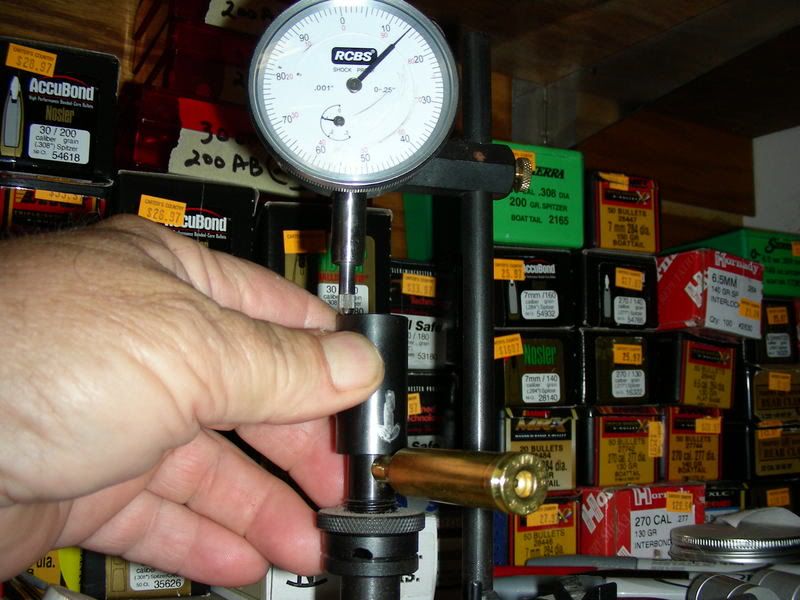 and a Bersin tool 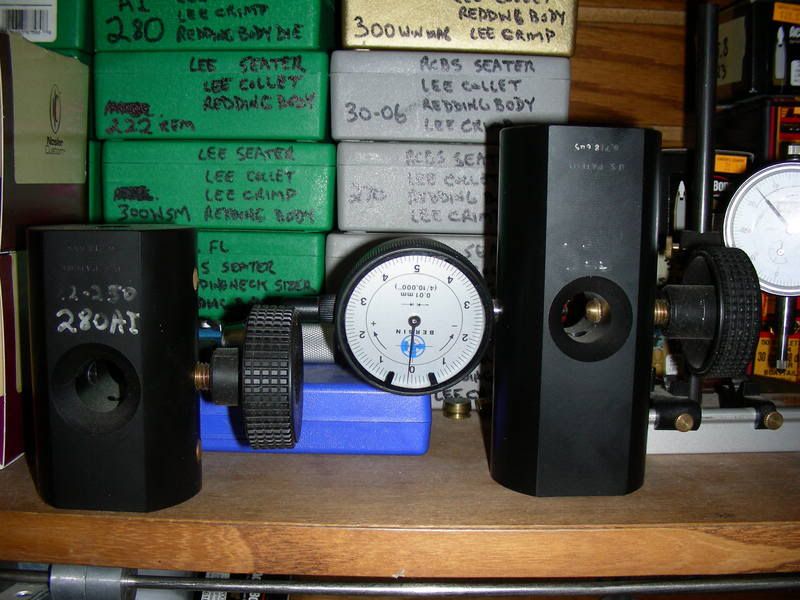 I have done side by side tests with cases loaded-at-the-same-time and shot-at-the-same-time and in every case the results have been positive in favor of crimping, again only with the Lee Factory Crimp. As far as benchresters not crimping, most of them seat into the lands which regulates their bullet release JUST LIKE A CRIMP DOES. Since most of us are hunters and do not want to seat into the lands for obvious reasons, crimping will help accomplish the same thing. Crimps marring the bullets?? Sheeeesh!! How do you think that compares with the scoring the lands put on the bullet?? Like 1000 to 1? You want me to start posting targets?? ____________________________________ There are those who would misteach us that to stick in a rut is consistency - and a virtue, and that to climb out of the rut is inconsistency - and a vice. - Mark Twain | Chinese Proverb: When someone shares something of value with you and you benefit from it, you have a moral obligation to share it with others. ___________________________________ | |||
|
| One of Us |
Woods, In all fairness to Boss, you can mess up the neck tension (and possibly the bullet jacket) by using a ROLL CRIMP on a bullet with no crimp groove. But as you have pointed out, the taper crimp from Lee's Factory Crimp Die should work. ______________________________ Well, they really aren't debates... more like horse and pony shows... without the pony... just the whores. 1955, Top tax rate, 92%... unemployment, 4%. "Beware of the Free Market. There are only two ways you can make that work. Either you bring the world's standard of living up to match ours, or lower ours to meet their's. You know which way it will go." by My Great Grandfather, 1960 Protection for Monsanto is Persecution of Farmers. | |||
|
One of Us |
Sorry mike I didn't mean to sound so angry. It just seems like lately there are a lot of short posts that just regurgitate old conventional ..... uhh ..... wisdom? without regard to discussion, mitigating circumstances or other reloader's experiences. Just like on the other thread about seating deeper increasing pressure and immediately we get several posts with 100% positive conviction even though they were wrong. It works out best if we are here to discuss with due regard to all the variables. Like I freely admit that in some guns a crimp may reduce accuracy and won't post that anybody that doesn't crimp has "got to be kidding". I learn something everyday but that something has to proved to me or at least illustrated with some experiences, not boldly stated as fact. Show me. ____________________________________ There are those who would misteach us that to stick in a rut is consistency - and a virtue, and that to climb out of the rut is inconsistency - and a vice. - Mark Twain | Chinese Proverb: When someone shares something of value with you and you benefit from it, you have a moral obligation to share it with others. ___________________________________ | |||
|
One of Us |
If I may venture to suggest it may be a case of how the crimping is done as to whether or not it improves accuracy. I does introduce another variable that would need to be properly controlled. But all anecdotal evidence in favour or crimpimg seems to come from Lee Factory Crimp Die users. That tells me something. How does crimping (with the Lee) affect case life? (If this works then I am going to try it!) Regards 303Guy | |||
|
| One of Us |
303 Guy, I was told several years ago (15+) by a long time reloader (he probably owned the prototype "Lyman tong tool") to only use the Lee Factory Crimp die. He said it was the only one he found worked correctly. I never doubted him, EVER. I heard the same from many of his crony's. I learned most of these old guys spent YEARS perfecting reloading technique, why the heck would I want to try and reinvent the wheel? I have never been too proud to live vicariously through other people’s mistakes or try something that multiple people tell me works. I believe if you anneal the cases regularly, it will not adversly affect case life. Some of my cases have been reloaded 6 or 7 times. I am sure some of his had more reloads on them than mine. | |||
|
One of Us |
I'm not sure there is a correlation between crimping and case life. Case life is more dependant upon annealing, sizing technique, case web thinning and primer pocket expansion. Probably to some extent on how much your die is sizing the case body and how much clearance you have in your chamber around a loaded neck as regards working your brass more. I have read that the case neck expands to the chamber walls before the bullet hits the lands and bullet grip therefore does not have any effect on accuracy but I don't agree with that. Although unproveable, it would seem to met that the bullet would move to the lands and even into the lands before the expanding gases could occupy the neck space and expand the brass to the chamber. The Lee Factory Crimp works much like their Lee Collet Neck Sizer in that the collets are squeezed onto the case neck. That would allow the loaded bullet to move since it is only held at the case head and center itself between the crimping collets. While loading I have taken a concentricity measurement before and after using the LFCD. The crimper did not eliminate runout and most of the times did not change it. In some cases it reduced runout a small percentage, like reducing one with a runout of .003" to .0025". In my tests, the standard deviation has been reduced about 10%, the velocity has increased an average of 10 fps and the groups size has been reduced an average of 1/8" when using the LFCD. I did 3 tests and proved it to myself and now just use the crimper. Not that any bullets ever moved but I don't even have to worry about them moving either. Is it necessary to crimp? Probably not. Can it help your accuracy? Probably about 75% of the time, yes. 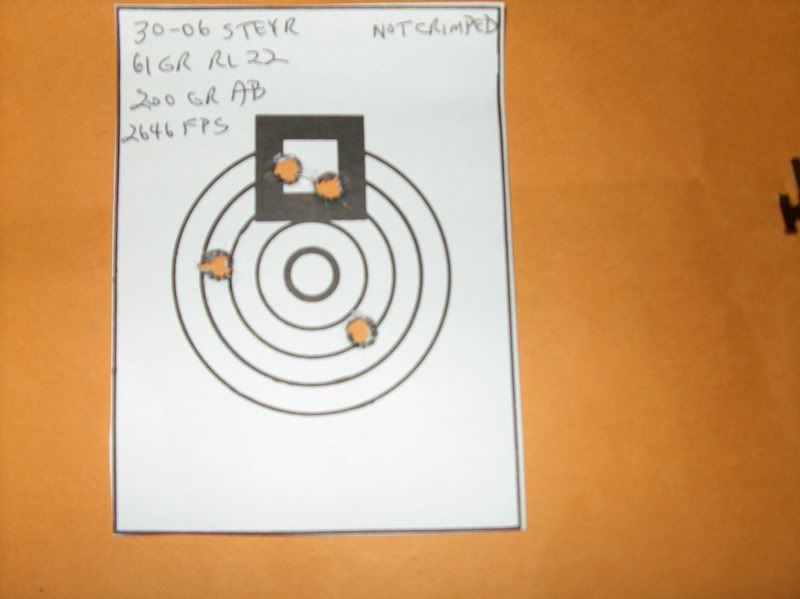 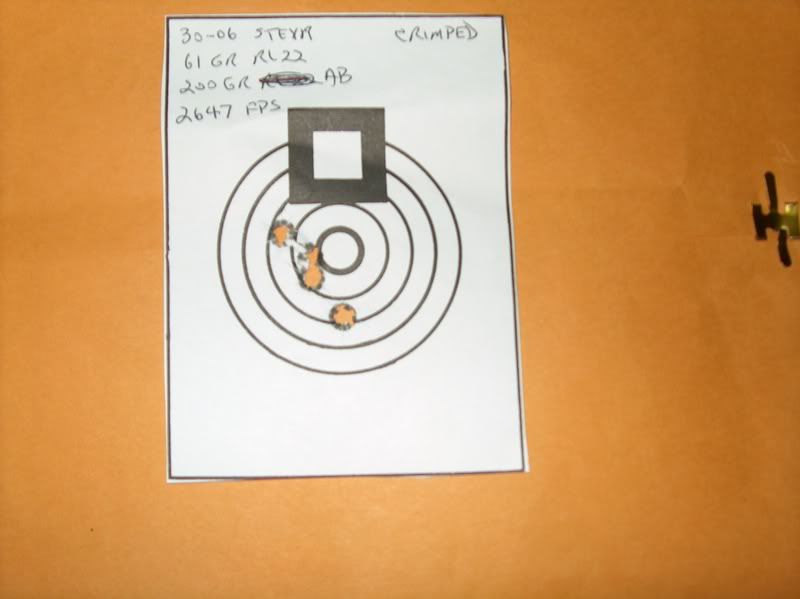 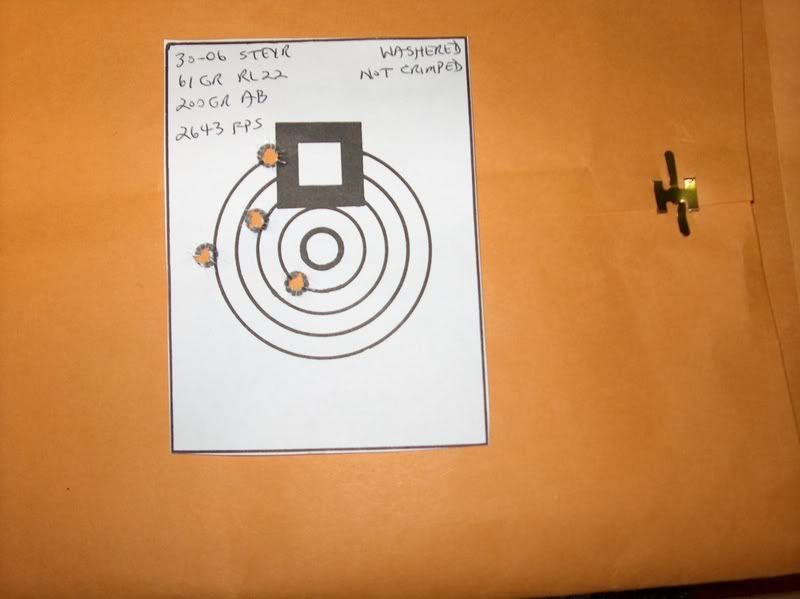 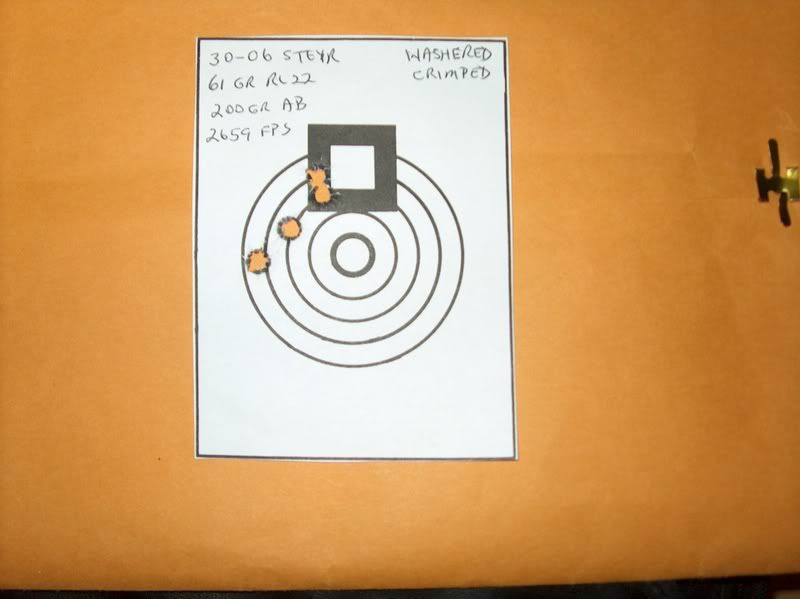 I had some other targets but I have misplaced them. ____________________________________ There are those who would misteach us that to stick in a rut is consistency - and a virtue, and that to climb out of the rut is inconsistency - and a vice. - Mark Twain | Chinese Proverb: When someone shares something of value with you and you benefit from it, you have a moral obligation to share it with others. ___________________________________ | |||
|
| One of Us |
Everyone is certainly entitled to their opinion --- I am a BR shooter 1K and like to win and I am not aware of a single instance where anyone who is successful or not in BR who crimps competition ammunition, also I seat off the lands a couple of thousandths. I just wish that everyone I competed against crimped their ammunition!!!! | |||
|
| One of Us |
Don't have any pix of the target shot by my son using crimped bullets in his Marlin 336, 30-30. With a 4x scope at 100 yards, he put three shots into a 1" group. Not bad shooting for an old lever gun. And yes, I made up the loads for him and crimped them on a place on the bullet that was smooth, no cannelure. The cannelure was out of location, so I just crimped where his rifle shot bullets best. | |||
|
| One of Us |
I use the Lee FCD on both .243 & .270 because I have personally seen better accuracy than from the very same loads without the crimp. Opinions aren't the same as results, so I'll do what works for me. | |||
|
One of Us |
Boss Hoss Wouldn't that be kinda comparable to lapping an already lapped high grade barrel to lapping a low grade, rough barrel? I am trying not to crimp because I am not set up for it. Looking at Woods's target pics, there can be no doubt that it works for him. May I ask whether you shoot only 'bench rest rifles' or do you perhaps also shoot 'sporting' class bench rest? I ask because if you did you might be able to enlighten us on how different class rifles behave with similar or dissimilar loading techniques. Thanks. Regards 303Guy | |||
|
| One of Us |
Am in Pecos for a funeral--will get back to you tomorrow after I get home. In short I load everything the same (sporters and BR) but will get into detail later. | |||
|
One of Us |
Thank you. Regards 303Guy | |||
|
| One of Us |
The first subject will be case preparation (new brass first)----sorry but as I said earlier EVERYTHING that is scribed here is for precision shooting so don’t flame me for the detail here. Use it for what it is worth but I prepare my brass the same for my competition rifles or my built sporters… This is a comprehensive task that done properly takes time and the right equipment(hand turning is not consistent enough as mine it turned on a lathe) plus is not going to even apply to most folks who use a SAAMI chamber and Norma or Lapua brass. The quality and consistency of you brass is going to have a significant bearing on you accuracy and what I mean by that is consistency. The only way to be consistent in your shooting is to make sure your components are. That being said what brand of brass should you buy? The most consistent brands that we have found in the BR game is Lapua and Norma. Not to say that other brands cannot be modified IN SOME CASES to be this consistent but they are not "as drawn" from the manufacturer. Lapua and Norma have drilled primer flash holes vs stamped holes like Remington and Winchester. If other brands are used than the aforementioned then the primer flash hole that was stamped should be chamfered to remove the burs that exist on the inside of the case. RCBS for example has a tool for this task specifically that allows for adjustment so that all holes can be free from any metal that will impede the ignited primer into the powder charge. This may not sound like something insignificant however, the powder in order to produce the most consistent burn has to be ignited the same every time or as close to the same as possible. Now take your die (I use a special die that has mandrels ground for each caliber) and set it up in your press being careful to square it up BUT do not size the case completely as we only want to run the expanding ball onto the neck and then back out to ensure a perfectly round hole. As a note examine the expander ball on the de-capping assembly and polish with some 600 paper to make it a smooth as possible and you will notice the difference plus it puts less stress on the neck when going in and back out. This is good JU JU for accuracy. The next part of case preparation involves the OAL of the case. When working with a new lot of brass (I usually buy enough for a barrel from the same lot 400pcs) always measure and uniform to as close as possible with a trimmer (many are available mine is a Forrester) as close to the min length as possible. When this operation is complete use a hand chamfering tool such as the ones sold by Sinclair to lightly chamfer the inside of the case to remove any rough surface and to allow easy seating of the bullet. We don’t want any shaved copper when we seat the bullet don’t ask me how I know---did it for many years until I learned the error of my ways. At this point, I will place the cases into the tumbler to remove any filings that may be in the case and just to make them pretty. Do NOT EVER EVER use any of the additives to your tumbling media (I only use untreated corn cob) esp. for rifles as the abrasives in that stuff will deposit on your brass and every time you fire it some goes down the tube and over time it can be damaging. For me when I build a rifle my Smith always cuts of about an inch and a half of the end of the blank and runs the finish reamer into it so I can use that piece to get my “almost final” length set. Works great to use that little stub and then the final fitment in the actual chamber. For a rifle that does not have a stub the following is What I Do: First I will remove the ejector (I also remove the firing pin and spring from the bolt) because it will pull the case to one side but on a Win or Mauser this is impossible to do without it being a real pain. Take a DUMMY round and use a black magic marker to color completely the ogive and then insert into the chamber and close the bolt. Upon removal check to see if there are any rifling marks on the bullet. When you do first see the marks, the thing to look for is a small engagement tic in the marked area (shiny spot) where EACH land is engaging the bullet completely. Each mark should look relatively the same if the smith who did the chamber knew what he or she was doing. Now depending on the rifle and what I use it for I will back off 2 to 4 thousandths, which will allow for any margin for error in my loaded ammunition. Most people who use a magazine will not be able to do this, as depending on the length of the throat the magazine (external or internal) is the limiting factor. By doing this we will allow the bullet to engage the rifling hopefully square with the lands and will absolutely contribute to greater accuracy as the bullet will start its journey concentric to the bore.. The old wives tail about jamming the bullet into the lands for best accuracy is just that. Not to say that in some rifles it may work but that will cause problems somewhere down the road that I will guarentee. This is because that any variation in your process will cause a dangerous pressure condition not to mention a change in POI.. There are other factors as well like concentricity of the chamber to the bore but we hit the highlights. | |||
|
| Powered by Social Strata | Page 1 2 |
| Please Wait. Your request is being processed... |
|

Visit our on-line store for AR Memorabilia

